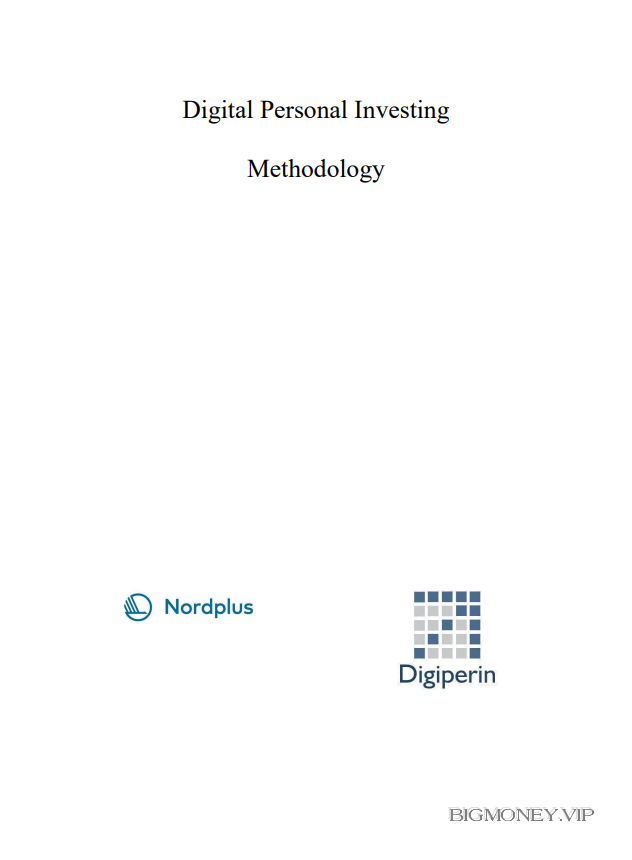Digital Personal Investing Methodology

INTRODUCTION
1.1. What is Digiperin?
Digital economy era make a new challenge for individuals responsibility in personal
financial planning. Individuals will need to have higher level financial sophistication to make
effective use of financial products and services and avoid fraud and costly mistakes. Digiperin
– abbreviation of Nordplus project – “Digital personal investing: available to anyone”.
Nordplus Adult 2020 collaboration project “Digital personal investing: available to
anyone” (NPHZ-2015/10009) the main aim is to develop personal digital investing skills
through greater digital personal financial management competencies.
Project partners / authors:
• Klaipeda State University of Applied Sciences (Lithuania), Eglė Hidri, Sabina
Jurkaitienė, Audrone Meškelienė, Aurelija Zonienė
o https://www.kvk.lt/
• Anmiro Oy (Finland), Jukka Kallio, Oili Niittynen
o https://www.anmiro.net/
• Art Smart Ltd (Latvia), Juris Riekstins, Marija Grinavica
o https://www.art-smart.eu/
1.2. Summary of research
As mobile payment tools and FinTech become more popular among consumers, it is
increasingly urgent to understand how technological change affects financial behavior and
indeed consumer vulnerability.
Citizens who use mobile payments are at greater risk in terms of their financial well-
being. This result demonstrates that the digital availability of financial services needs to be
accompanied by greater financial management skills. There is a need of being aware of the
existence of non-traditional financial products and services provided through digital means and
related to possibility to manage individuals’ own savings and investing for a better future. For
this reason, Digiperin conducted research on the most popular digital investment instruments
for individuals in Lithuania, Latvia and Finland.
The research revealed that the most popular digital personal investment instruments are
stocks, cryptocurrencies, forex trading (currencies), investment funds, bonds (company and
state), crowdfunding, commodities, voluntary pension insurance & long-term pension savings
and forests. There was identified their advantages, disadvantages, similarities and differences
in the Baltic (Lithuania and Latvia) and Nordic (Finland) countries.
These examples of digital personal investment opportunities are explored and
integrated into this methodology. Digiperin expects that this methodology will encourage
individuals to start digital investing and introduce advanced investors to the possibilities of
diversifying their digital investment portfolio
1.3. Structure of methodology paper
The methodology consists of an Introduction, six chapters, Curriculum, Vocabulary of
Terms and References.
Chapter 2 presented FinTech aim, definition and understanding.
Chapter 3 presented Personal Financial Management – five main levels for making
financial investments.
In Chapter 4 there are described two essential components – technical (digital)
competences and the material resources that the individual requires for the investing that must
be evaluated in order to begin digital investing.
Chapter 5 presented digital investment targets: stocks, cryptocurrencies, forex trading
(currencies), investment funds, bonds, peer to peer lending, commodities, crowdfunding
pension funds, forests. Each tool is describing here, indicating the potential risk of investing,
the main steps of investing, is presented list of active operators in Finland, Latvia and
Lithuania.
In Chapter 6 there is provide digital investing plan, the steps which will help to make
wise financial decisions.
The references in each chapter will provide a search opportunity to study the questions
You want in more detail. The term vocabulary at the end of the methodological tool will make
it simpler to recognize each term and to understand them all at the same time.
2. FINTECH
Fintech (Financial technology) can be defined as being computer programs and other
technology used to support or enable banking and financial services. The FinTech aim is to
compete with traditional financing methods in the provision of financial services. It is an
emerging industry that uses technology to improve financing1
.
In March 2018, the European Commission adopted an action plan on FinTech to foster
a more competitive and innovative European financial sector. The action plan sets out 19 steps
that the Commission intends to take to:
• Enable innovative business models to scale up at EU level;
• Support the uptake of new technologies such as blockchain, artificial
intelligence and cloud services in the financial sector;
• Increase cybersecurity and the integrity of the financial system.
Most notably, European Commission speaks about digital financing which can be seen
to be a synonym for Fintech. Digital finance is the term used to describe the impact of new
technologies on the financial services industry. It includes a variety of products, applications,
processes, and business models that have transformed the traditional way of providing banking
and financial services.2
While technological innovation in finance is not new, investment in new technologies
has substantially increased in recent years and the pace of innovation is exponential. We now
interact with our bank using mobile technology. We make payments, transfer money and make
investments using a variety of new tools that were not there few years ago. Artificial




